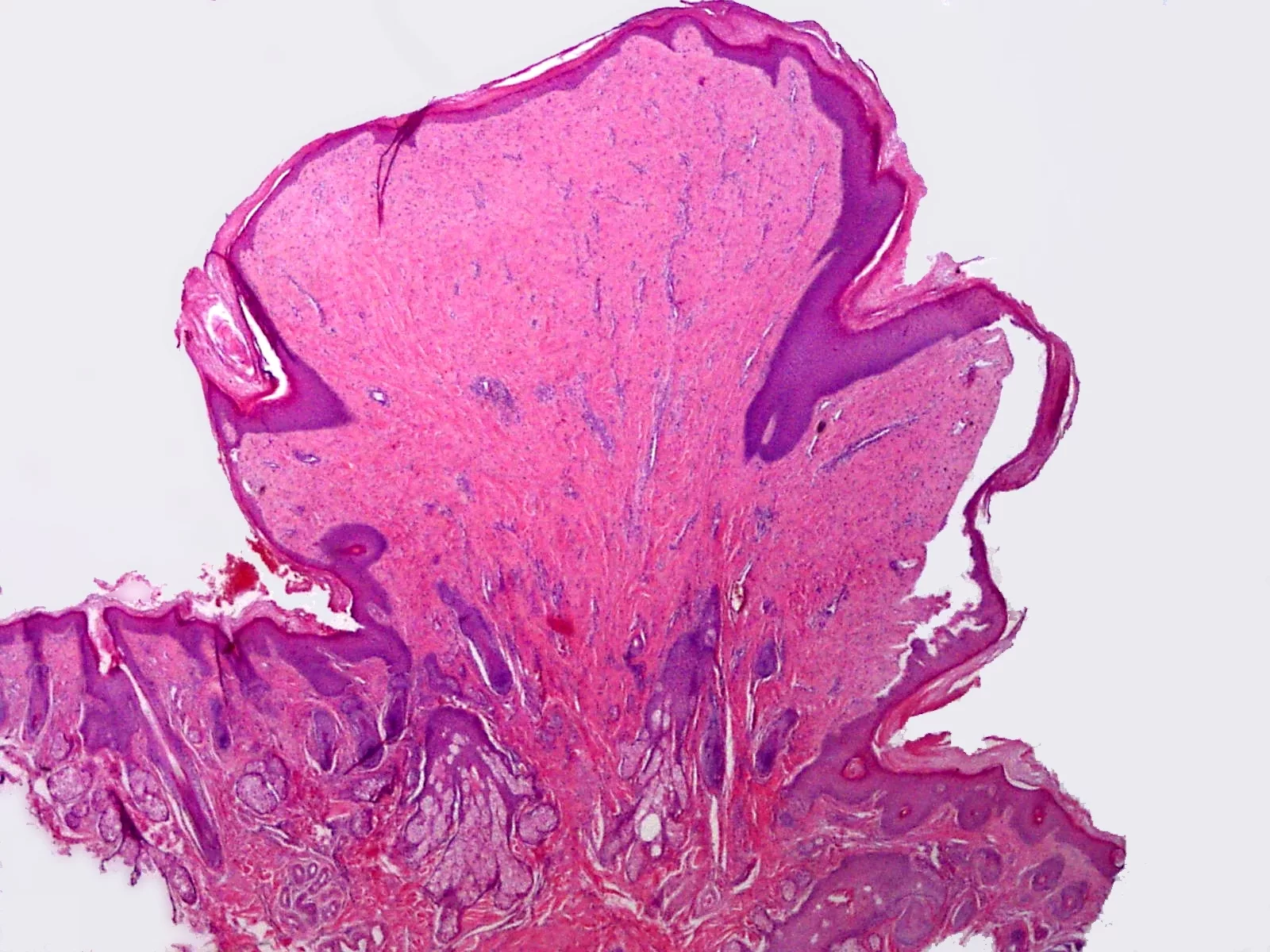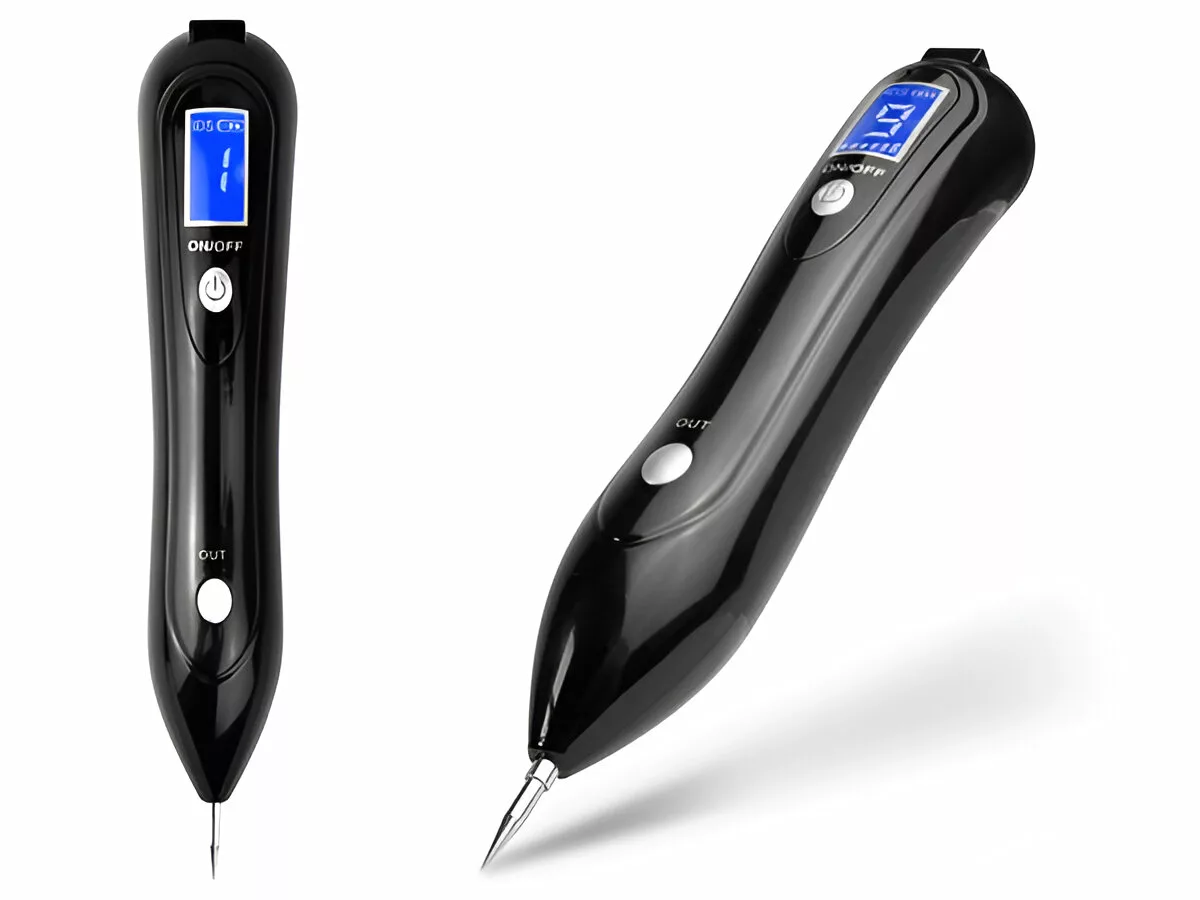Skin Tags, or Acrochordons, are small, soft, benign skin growths that grow on areas where the skin creases or rubs together. These flaps are connected to the skin with a small stalk and often appear on the neck, underarms, groin, and even below the eyelids. About 50 percent of the adults, both men and women, are victims of these conditions.1Banik R, Lubach D. Skin tags: localization and frequencies according to sex and age. Dermatologica. 1987;174(4):180–183. doi:10.1159/000248890
These protrusions are usually of the same color as your skin, and occasionally, if irritated by clothing or get infected, then they may turn reddish. Although skin tags are harmless, they are annoying for cosmetic reasons.
It’s important to remember that a skin tag is not a wart, a mole, or a sign of a disease. It is simply an excessive growth of the skin tissue that is usually associated with age, family history, or rubbing.
Where do Skin Tags occur?
Skin tags can grow anywhere on the body; however, they are most commonly observed in areas where skin folds, rubs, or experiences constant friction. These locations include:2Kahana M, Grossman E, Feinstein A. Skin tags: a cutaneous marker for diabetes mellitus. Acta Derm Venereol. 1987;67(2):175–177. PMID: 3033855
- Neck
- Underarms
- Eyelids
- Under the breasts
- Groin area
- Thigh creases
- Folds of the back or torso (particularly of overweight people)
Continuous exercise, perspiration, friction, and skin-to-skin contact are known to cause tags on the body in these areas. As is the case with those who are wearing neck jewelry or tight-fitting clothes may develop tags around those points.
Skin Tags on Genitals: Penis, Scrotum & Vulva:
In these areas, only those people are prone to develop skin tags who have some reason for friction. Otherwise, these areas are less commonly affected.3Tamegai Y, et al. Acrochordon of the vulva: a case report. J Obstet Gynaecol Res. 2005;31(5):432–434. doi:10.1111/j.1447-0756.2005.00299.x
Why do they occur in specific locations, rather than others? The exact cause is under study, but obesity, genetic, and hormonal changes are suspected.
Therefore, when you suddenly discover a new tag, or in a location you would not have expected, there is no need to freak out; chances are high that it is just another harmless skin tag occurring in a friction-sensitive area.
Causes & Risk Factors for Skin Tags?
Anybody is susceptible to these, but some groups are more prone to them. Here’s the factors that make you prone to getting them:4Crook MA. Skin tags and the atherogenic lipid profile. J Clin Pathol. 2000;53(12):873–874. doi:10.1136/jcp.53.12.873
- Age: More common in adults over 40
- Obese or overweight individuals
- Patients with Diabetes or Insulin Resistance
- Pregnant Women can be affected due to hormonal changes.
- Individuals who have a Family History
- In individuals who have HPV (Human papillomavirus), there are some findings connecting some forms of HPV that cause skin tags, though this is still disputable.
- Skin tags appear in both men and women equally.
- Skin tags mostly occur in the adult population, but sometimes they occur in children who, in most cases, have them on the neck and underarms, especially if they are overweight.
What causes Skin Tags on the face?
Face skin tags usually form because of friction between the skin and clothes, jewelry, or regular rubbing against the skin, especially around the eyelids or neck. Hormonal changes, genetics, as well as aging may also predispose one to develop them.5Kilic A, Goksugur N, Isakofoglu O, et al. The relation between insulin resistance and skin tags. Clin Exp Dermatol. 2010;35(4):461–464. doi:10.1111/j.1365-2230.2009.03508.x
Are Skin Tags contagious?
Among the countless myths about skin tags is that they can be infectious, and guess what? They are not.6American Academy of Dermatology Association. Skin tag. Available at: https://www.aad.org You cannot contract skin tags through another person, and nobody will spread skin tags to other parts of their body by touching or scratching them.
There is no need to be worried about sharing towels, razors, or clothes with someone who has them.
Microscopic Picture Of Skin Tags
At the microscopic level, skin tags consist of a core of collagen fibers, with a blood supply (capillaries) surrounding them. The nerve endings are located at the upper layers of the dermis, which is why the skin tags may tend to be sensitive to irritation and trauma. Their morphological texture ranges between smooth, fleshy structures and wrinkled on those that are bigger tags.7Daboul DG, Axiotis CA. Acrochordon. In: StatPearls [Internet]. Treasure Island (FL): StatPearls Publishing; 2024. [Accessed via NCBI Bookshelf]

Image Credit: LWozniak & KWZielinski – Own work, licensed under CC BY-SA 3.0, via Wikimedia Commons
Types of Skin Tags
Skin tags, or acrochordons, come in different shapes and sizes:8James WD, Berger TG, Elston DM. Andrews’ Diseases of the Skin: Clinical Dermatology. 12th ed. Elsevier; 2015.
- Classic skin tags: These are flesh-colored or slightly dark, soft, and sometimes hang off the skin. They are the most widespread ones.
- Flat skin tags: They are smaller and less pronounced, so they might resemble a bump rather than hanging tags.
- Filiform tags: These are long, thin, and strand-like skin tags that mostly appear on the neck, eyelids, or armpits.
- Multiple clustered tags: Sometimes, small tags are clustered in a region, mostly in a fold or a friction area.
Genital Warts vs. Skin Tags
Genital warts and skin tags can look similar, but they are very different conditions.9Workowski KA, Bachmann LH, Chan PA, et al. Sexually Transmitted Infections Treatment Guidelines, 2021. MMWR Recomm Rep. 2021;70(4):1–187. doi:10.15585/mmwr.rr7004a1
| Feature | Genital Warts | Skin Tags |
| Cause | HPV (sexually transmitted virus) | Friction, genetics, hormones |
| Appearance | Bumpy, cauliflower-like, clustered | Soft, smooth, skin-colored, often on a stalk |
| Texture | Rough or grainy | Smooth or slightly wrinkled |
| Color | Flesh-colored, pink, gray | Flesh-toned or slightly darker |
| Location | Genital area, inner thighs, anus | Genitals, neck, armpits, eyelids, under breasts |
| Symptoms | May itch, burn, or multiply | Usually painless; may get irritated |
| Contagious? | Yes – spreads through sexual contact | Requires a medical exam |
| Cancer Risk | Possible with certain HPV strains | None – completely benign |
| Diagnosis | Reduce friction, manage weight, and blood sugar | Usually by visual inspection |
| Treatment | Reduce friction, manage weight, and blood sugar | Optional: freezing, cutting, cauterization |
| Prevention | HPV vaccine, safe sex | Reduce friction, manage weight and blood sugar |
| Doctor Visit? | Always recommended | If unsure or if removal is desired |
When you do not know whether a bump is a wart or a tag, it is significant to visit a medical expert to confirm the diagnosis and receive effective treatment.
Are Skin Tags Cancerous?
In case something new has grown on your skin, you should pay attention to it, particularly when its size changes quickly. If it is a skin tag, then it is not a cancer at all. These little pieces of skin do not carry the risk of becoming cancerous even when they are not bothered for years.10Nambudiri VE, et al. Acrochordon. In: UpToDate. [Accessed July 2024]
However, when you are attempting to determine whether the lesion is a skin tag or not, use the following to help you. The common skin tags are:
- Smooth and soft, or a little wrinkled
- Fleshy brownish color or darker
- The size is small (normally 2-5mm, but sometimes bigger)
- Hanging from the skin by a narrow stalk
- Not painful unless irritated
In case growth is not a skin tag, the following signs indicate that it should be examined by a physician:11Geller AC, Swetter SM, Brooks K, et al. Screening, early detection, and trends for melanoma. Curr Oncol Rep. 2008;10(6):491–498. doi:10.1007/s11912-008-0076-6
- Fast growth or an increase in size
- Purple skin tag
- Thrombosed skin tag
- Irregular borders
- Black or multiple colors
- Bleeding or oozing for no reason
- Itching or persistent pain
However, not all skin growths are skin tags. Some cancers, like basal cell carcinoma or melanoma, can start out looking similar to a skin tag, especially in the early stages. That’s why dermatologists often recommend that you don’t self-diagnose.
Sometimes, doctors might remove the tag and send it for a biopsy, especially if there’s anything unusual about its appearance or growth pattern. Biopsies are quick and minimally invasive, usually done right in the dermatologist’s office.
Skin Tag Removal
When to Remove a Skin Tag?
Skin tags are usually harmless and don’t need treatment. However, removal is a good idea if:12Gold MH. Treatment of skin tags: Cryosurgery and electrosurgery. Clin Dermatol. 2001;19(3):273–275. doi:10.1016/S0738-081X(00)00210-5
- They hurt, bleed, or irritate.
- They interfere with shaving, clothing, or daily tasks.
- They affect your confidence due to cosmetic harm.
- A doctor recommends testing.
The sudden appearance of many tags, especially with other symptoms like fatigue or skin darkening, should be evaluated by a doctor.
How Dermatologists Remove Skin Tags?
Visiting a dermatologist is the safest way to remove skin tags. They use sterile tools and precise methods, reducing the risk of infection, scarring, or misdiagnosis. Most procedures take less than 15 minutes and require little to no downtime.13Zeligman I, et al. Treatment of acrochordon: A comparative clinical trial. J Dermatolog Treat. 2016;27(2):150–153. doi:10.3109/09546634.2015.1077449

- Cauterization involves burning off the tag using heat or a chemical. It seals the wound while removing the tag, which usually falls off in a few days. Discomfort is minimal.
- Cryosurgery freezes the skin tag with liquid nitrogen. The extreme cold kills the tissue, causing the tag to fall off within a week. It’s ideal for small tags and is quick and relatively painless.
- Ligation uses a surgical thread to cut off the blood supply to the tag. Over time, it dries out and drops off. It’s similar to over-the-counter banding kits but more precise.
- Excision cuts the tag off with surgical scissors or a scalpel. Local anesthesia may be used to numb the area. This method is best for larger or stubborn tags.
After removal, your dermatologist may advise keeping the area clean and applying ointment to promote healing. They can also examine the growth to confirm it’s noncancerous.
Are At-Home Skin Tag Removers Safe?
While many over-the-counter products and natural remedies claim to remove these tags, medical experts advise caution. At-home skin tag removal is generally not recommended due to the increased risk. These risks may include:14American Academy of Dermatology Association. How to safely remove skin tags. https://www.aad.org15
- Scarring and permanent skin damage
- Infections from non-sterile tools or improper technique
- Excessive bleeding, especially with cutting or ligation methods
- Incomplete removal, leading to recurrence
- Misdiagnosis, where a potentially serious condition like skin cancer is mistaken for a skin tag
- Irritation or burns from acids, essential oils, or other harsh substances
Some methods, such as freezing kits, removal bands, and creams, may be widely available, but they are not suitable for use near sensitive areas like the face, genitals, or eyelids. Even natural options like tea tree oil or apple cider vinegar carry a risk of skin irritation, especially when used incorrectly.
Due to these potential dangers, it’s always best to seek guidance from a licensed dermatologist for safe and effective removal. A healthcare provider can accurately diagnose the skin growth and offer a medically approved treatment tailored to your skin type and the location of the tag.
How to Prevent Skin Tags?
Skin tags can be reduced, but they can’t be prevented forever, especially if you’re genetically prone. The following risk factors and health conditions can reduce them:16Sari R, Serter R, Akcay F, et al. The metabolic profile in patients with skin tags. Clin Exp Med. 2010;10(4):193–197. doi:10.1007/s10238-010-0077-5
- Maintaining a healthy weight is necessary because obesity increases skin folds and friction, which in turn causes tag formation.
- Wear loose, breathable clothing: This reduces rubbing on the skin, especially in common tag areas like the neck, underarms, and groin.
- Keep skin dry: Moist folds increase irritation. Use powders or moisture-wicking fabric in these areas.
- Monitor blood sugar: People with insulin resistance or diabetes are more likely to develop skin tags, so managing your blood sugar may help reduce the risk.
- Avoid constant jewelry or accessories: Repeated rubbing from necklaces, tight collars, or straps can promote tag development on the neck or underarms.
While not all these tags are preventable, these habits can lower the chances of developing new ones over time.
Common Misconceptions
Here is the answer to some common myths and misconceptions about these tags.17Griffiths CE, Barker JN, Bleiker TO, et al. Rook’s Textbook of Dermatology. 9th ed. Wiley-Blackwell; 2016.
Can I use Wart Remover on Skin Tags?
No. Wart treatments contain strong acids like salicylic acid, which can damage healthy skin. Skin tags aren’t caused by viruses, so wart treatments are ineffective and potentially harmful.
Will removing Tags cause more to grow?
This is a myth. Removing a skin tag does not cause others to grow. However, if you’re genetically prone or have underlying conditions like insulin resistance, new tags may appear over time, unrelated to the removal.
What looks like a Skin Tag but isn’t?
Several skin conditions can resemble them. These include seborrheic keratoses (benign growths), warts (caused by HPV), moles, neurofibromas (nerve tissue growths), and even early-stage skin cancer. That’s why professional evaluation is important for any new or changing skin growth.
Summary
Skin tags are small, benign tumors that occur frequently among adults aged 40 years or more, individuals with weight-related disorders, and hormonal changes. They are normally painless but can be irritating, or awkward.
You can remove them at home in a safe mode, but you may buy over-the-counter products, yet the results are not assured, and the risk is also increased. The dermatologist provides quick, safe, and effective pulling out, particularly of tags in sensitive areas.
Do not use DIY treatments, such as wart removers or unproven creams, which may only aggravate or damage the affected area. Some unusual appearance of skin tags in large numbers and some other positions should also bring one to a doctor, as it may indicate a health problem.
In short, skin tags don’t need to stay if they bother you, and removing them won’t make things worse.
Refrences
- 1Banik R, Lubach D. Skin tags: localization and frequencies according to sex and age. Dermatologica. 1987;174(4):180–183. doi:10.1159/000248890
- 2Kahana M, Grossman E, Feinstein A. Skin tags: a cutaneous marker for diabetes mellitus. Acta Derm Venereol. 1987;67(2):175–177. PMID: 3033855
- 3Tamegai Y, et al. Acrochordon of the vulva: a case report. J Obstet Gynaecol Res. 2005;31(5):432–434. doi:10.1111/j.1447-0756.2005.00299.x
- 4Crook MA. Skin tags and the atherogenic lipid profile. J Clin Pathol. 2000;53(12):873–874. doi:10.1136/jcp.53.12.873
- 5Kilic A, Goksugur N, Isakofoglu O, et al. The relation between insulin resistance and skin tags. Clin Exp Dermatol. 2010;35(4):461–464. doi:10.1111/j.1365-2230.2009.03508.x
- 6American Academy of Dermatology Association. Skin tag. Available at: https://www.aad.org
- 7Daboul DG, Axiotis CA. Acrochordon. In: StatPearls [Internet]. Treasure Island (FL): StatPearls Publishing; 2024. [Accessed via NCBI Bookshelf]
- 8James WD, Berger TG, Elston DM. Andrews’ Diseases of the Skin: Clinical Dermatology. 12th ed. Elsevier; 2015.
- 9Workowski KA, Bachmann LH, Chan PA, et al. Sexually Transmitted Infections Treatment Guidelines, 2021. MMWR Recomm Rep. 2021;70(4):1–187. doi:10.15585/mmwr.rr7004a1
- 10Nambudiri VE, et al. Acrochordon. In: UpToDate. [Accessed July 2024]
- 11Geller AC, Swetter SM, Brooks K, et al. Screening, early detection, and trends for melanoma. Curr Oncol Rep. 2008;10(6):491–498. doi:10.1007/s11912-008-0076-6
- 12Gold MH. Treatment of skin tags: Cryosurgery and electrosurgery. Clin Dermatol. 2001;19(3):273–275. doi:10.1016/S0738-081X(00)00210-5
- 13Zeligman I, et al. Treatment of acrochordon: A comparative clinical trial. J Dermatolog Treat. 2016;27(2):150–153. doi:10.3109/09546634.2015.1077449
- 14
- 15
- 16Sari R, Serter R, Akcay F, et al. The metabolic profile in patients with skin tags. Clin Exp Med. 2010;10(4):193–197. doi:10.1007/s10238-010-0077-5
- 17Griffiths CE, Barker JN, Bleiker TO, et al. Rook’s Textbook of Dermatology. 9th ed. Wiley-Blackwell; 2016.

